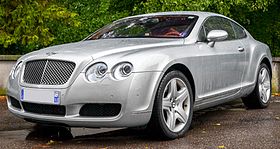Bentley Continental GT
| Bentley Continental GT | |
|---|---|
 |
|
| Overview | |
| Production | 2003–present |
| Body and chassis | |
| Class |
Grand tourer (F) Personal luxury car coupe |
| Body style | 2-door 2+2 coupé 2-door 2+2 convertible |
| Platform | Volkswagen Group D1 |
| Chronology | |
| Predecessor |
Bentley Continental R Bentley Continental T |
| First Generation | |
|---|---|
 |
|
| Overview | |
| Production | 2003–2011 |
| Assembly | Crewe, England, United Kingdom |
| Designer | Raul Pires; Dirk van Braeckel (2000) |
| Body and chassis | |
| Body style | 2-door 2+2 fastback 2-door 2+2 convertible |
| Layout |
Longitudinal front-engine, Torsen permanent four-wheel drive |
| Platform | Volkswagen Group D1 |
| Related |
Bentley Continental Flying Spur Volkswagen Phaeton |
| Powertrain | |
| Engine | 6.0 L W12 twin-turbo |
| Transmission | 6-speed ZF 6HP26A tiptronic automatic |
| Dimensions | |
| Wheelbase | 2,746 mm (108.1 in) |
| Length | 4,808 mm (189.3 in): 2003-05 4,804 mm (189.1 in): 2006-present |
| Width | 1,918 mm (75.5 in): 2003-05 & GTC 1,946 mm (76.6 in): Supersports 75.4 in (1,915 mm): 2009-present Coupe 77.4 in (1,966 mm): 2009-present Convertible |
| Height | 1,390 mm (54.7 in) 1,380 mm (54.3 in): Speed 1,398 mm (55.0 in): GTC |
| Curb weight | 2,350 kg (5,181 lb) 2,485 kg (5,478 lb): GTC |
| Second Generation | |
|---|---|
 |
|
| Overview | |
| Production | 2011–present |
| Assembly | Crewe, England, United Kingdom |
| Designer | Dirk van Braeckel |
| Body and chassis | |
| Body style | 2-door 2+2 coupé 2-door 2+2 convertible |
| Layout |
Longitudinal front-engine, Torsen permanent four-wheel drive |
| Platform | Volkswagen Group D1 |
| Powertrain | |
| Engine |
6.0 L W12 twin-turbo 4.0 L V8 twin-turbo |
| Transmission | 8-speed tiptronic automatic |
| Dimensions | |
| Wheelbase | 2,746 mm (108.1 in) |
| Length | 4,806 mm (189.2 in) |
| Width | 1,944 mm (76.5 in) |
| Height | 1,404 mm (55.3 in) |
| Curb weight | 2,320 kg (5,115 lb) |
The Bentley Continental GT is a grand tourer produced by British automaker Bentley Motors since 2003. It was the first car released by Bentley under Volkswagen AG-management after their acquisition of the company in 1998, and the first ever Bentley to employ "mass production" manufacturing techniques. It shares a platform with the Volkswagen Phaeton.
In 1994 Rolls Royce Motors (who at that time owned the Bentley brand) previewed a convertible concept car at the Geneva Motor Show - the Concept Java. The car was designed to be a highly desirable Bentley, but smaller, more affordable, yet still exclusive in order to maintain the integrity of the brand. It was to appeal to a new range of potential buyers and generate increase sales volume for Rolls Royce (at the time the current Bentley Continental R was an ultra-exclusive £180,000 in the UK, within reach of a very select market selling only 2-300 units a year). The Concept Java never made it into production in the form seen in 1994 (although 13 cars were made for the Sultan of Brunei). However the Bentley Continental GT realised the concept of the Java as a more affordable Bentley, manufactured in much larger volumes. Whilst external styling is different, the dashboard design was clearly influenced by the Java.
The vehicle was unveiled in 2003 Geneva Motor Show, followed by Le Mans, 2003 Goodwood Festival of Speed, 2003 annual Bentley Drivers Club meeting at Silverstone,. Very importantly, the car differed significantly from the previous Continental R & T models in terms of its concept: although much of the car is hand assembled, it is a mass-produced car made in significantly larger numbers. It is not a coachbuilt car. As a result, the price at launch was significantly less than the Continental R (approximately half) and this immediately exposed the car to a much wider and new customer base as a more affordable car.
The Continental GT is equipped with a 6.0 litre twin-turbocharged W12 engine, which produces a DIN-rated motive power output of 560 metric horsepower (412 kW; 552 bhp) at 6,100 rpm, and torque of 650 newton metres (479 lbf·ft) at 1,600-6,100 rpm.Torsen-based permanent four-wheel drive is standard. It will accelerate from 0 to 100 kilometres per hour (0.0 to 62.1 mph) in 4.8 seconds, and go on to reach a top speed of 318 kilometres per hour (197.6 mph).
...
Wikipedia
